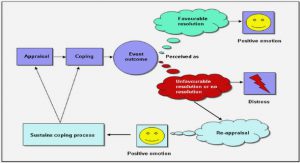Get Complete Project Material File(s) Now! »
RESEARCH DESIGN AND METHODOLOGY
This chapter described the research design and the methodological dimension of the manner in which the study was conducted in its intended purpose of exploring learners‟ on-line interactivity in an Open Distance Learning (ODL) institution with other learners, educator, study materials, and the open distance learning institution itself.
RESEARCH DESIGN
Polit and Beck (2008:66) described research design as an overall plan for obtaining any answers to the questions being studied and to handle some of the difficulties during the research process. According to Burns and Grove (2009:275), research designs are blueprints for conducting a study that maximise control over factors that could interfere with the validity of the findings. Research designs are developed to meet the requirements of a study. They are plans and procedures for research that spare the decisions from broad assumptions to detailed methods of data collection and analysis (Creswell 2009:233).
The design is a set of instruction to the researcher to gather and analyse data in certain ways that will control who and what is to be studied (Wood & Ross-Kerr 2011:116). Polit and Hungler (1999:166) indicate that selecting a good research design should be guided by an over-reaching consideration, namely, whether the design does the best possible job of providing trustworthy answers to the research questions. In this study, a mixed method type of research design was used, embracing both quantitative and qualitative research approaches in order to achieve the research objectives and to address the research problem. The two approaches are discussed individually below.These are referred to as the description of the phenomenon about which little is normally known. From the data collected, patterns or trends may emerge and possible links between variables can be observed, but the emphasis is on the description of phenomena (Parahoo 2006:467). Descriptive studies provide the basis for the conduct of correlational, quasi-experimental and experimental studies. They offer researchers a way to discover new meaning, describe what exists, and determine the frequency with which something occurs and categorises information (Burns & Grove 2009:25). Furthermore, descriptive studies offer the types of statistics answering descriptive questions by such measures as frequency, central tendency and dispersion (Parahoo 2006:467).
Descriptive statistical analysis refer to the analysis of numeric data obtained for the purpose of obtaining summary indicators that describe a sample, a population or the relationship among the variables in each. Descriptive research is concerned with exploring the attributes of a phenomenon (Teddlie & Tashakkori 2009:333). During the review of the literature, no study was found to address the HSM learners‟ on-line learning in an ODL environment with consideration of prospects and challenges of interactivity.
Since this study is descriptive and explorative, the focus was on describing the HSM learner‟s on-line interaction as well as exploring their experiences in on-line interaction with other learners, educators, study materials, and the ODL institution itself.
The qualitative approach
Bowling (2009:380) describes qualitative research as a method of naturalistic enquiry which is equally less obtrusive than quantitative investigations and does not manipulate a research setting. It aims to understand the individual‟s view without making any value judgments during data collection. Qualitative studies are a means for explaining and understanding the meaning individuals or groups ascribed to a social or human phenomenon.
DATA ANALYSIS AND PRESENTATION
This chapter presented the data analysed from the three phases of triangulated data collection. The data analysis is discussed according to the sequence of the study objectives and indicated data collection processes.
RESULTS AND INTERPRETATION
The results of phase 1 (myUnisa discussion forum) and phase 2 (focus group interviews) were analysed qualitatively. In phase 3 (online questionnaire), the results were presented by using bar and pie diagrams and tables. Statistical Analysis Systems (SAS), version 39 was also utilised to quantify and interpret data.
Of the 614 second year, first semester HMS learners, only 23 learners participated in the discussion forum; and of 765 third year learners, only 30 learners participated in the discussion forum. A total of 53 learners thus participated in the empirical aspects of this study. The findings are therefore based on those who participated in the interaction of the discussion forum. The codes were allocated to the participants. The codes were, (T) for third year learners and (S) for second year learners followed by a number. This was done in order to assist the researcher in identifying the recurring themes for data analysis purposes.
The aim of myUnisa discussion forum was to determine the nature/type and trends and patterns of interaction between the learners and educators. What emerged from the analysis was academic and administrative type of on-line interaction from the learners. These were addressed to the learners themselves, educators and the university.
FINDINGS, CONCLUSIONS, LIMITATIONS AND RECOMMENDATIONS
The general purpose of the study was to explore the extent to which the on-line interactivity mode is utilised by the HSM learners in an open distance learning institution in order to facilitate learning. The previous chapter presented the three phases of data collection and analysis of the results obtained from those three phases, outlined as follows:
Phase 1: Data was collected by means of the discussion forum to determine the nature of on-line interaction between the learners and their educators.
Phase 2: Data was collected by means of focus group interviews in order to explore the learners‟ on-line interactivity in an ODL institution with other learners, their educators, their study materials, and the open distance learning institution.
Phase 3: Data was collected by utilising the on-line questionnaire in order to determine how on-line interactive tools could be used to enhance interactions between learners and their peers, their educators, their study materials, and their ODL institution.
Mixed research methods were opted for in order to enhance a triangulated approach to the study, where triangulation refers to the use of multiple methods, data collection strategies and data sources to obtain a more complete picture of the research subject and to cross-check information (Gay, Mills & Airasian 2009:608).
Accordingly, the discussion focuses on the consolidation of the interpretation of the discussion forum, focus group interviews, and the on-line questionnaire. Data from original sources in other studies were also used to contextualise and locate the discussion within comparable national and international milieus. The developed summary obtained will help in articulating concomitant recommendations of the study. The limitations of this study and the recommendations for further study are also included in the discussion.
SUMMARY OF THE DISCUSSION OF THE FINDINGS OF THE THREE PHASES OF DATA COLLECTION
The discussion to follow consolidates and summarises the discussion of the three phases of data collection. The intended outcome of this trajectory of discussion is to produce a logically coherent picture of the achieved objectives and the recommendations made in this study. The findings were based on the theoretical framework of Bruner‟s constructivist theory; the conversation theory of Pask; the social development theory of Vygotsky; and Moore‟s transactional distance theory. Vygotsky‟s ideas are considered relevant as they address pedagogy and learner interaction; Brunner‟s ideas explicate students‟ interaction with the world by exploring and manipulating objects; while Pask‟s ideas illuminate that learning occurs through conversations; and Moore‟s theory is also more relevant to distance learning as it explains the relationship between participants in a distance learning situation. The relevance, implications, and impact of these theories is reflected in the ensuing discussion.
Trends in learner on-line interaction
Learners use their minds in order to understand and make sense of their experiences when interacting with their learning materials, their educators, their peers, and their learning resources (Vygotsky 1978:56-57). It is these experiences that necessitated a study and monitoring of their trends of interaction. The implications of these trends of interaction are illustrated sequentially in accordance with the months during which learners engaged in associated learning activities.
The aim of this study was to explore the extent to which the on-line interactivity mode of teaching and learning is utilised by the HSM learners in an open distance learning institution. The motivation for such an exploration is premised on the intention towards a better understanding of learners‟ on-line interactivity in ODL institutions.
The objectives of this study have been addressed, and the research questions were effectively responded to. Learners do encounter major challenges, which have academic, technological, institutional, and administrative ramifications and warrant concomitant resolution and support.
Learners who are located in rural areas and outside South Africa do not benefit much from on-line interactivity due to challenges of poor connectivity and inaccessibility to some of the interactive tools.
Challenges of learners‟ lack of sufficient on-line time and below-average computer literacy were observed. Educators‟ delays in responding to the learners‟ queries also frustrated the learners, the majority of whom do under-utilise on-line interactive tools with their fellow learners and educators, study materials, and ODL institution.
The viability and relevance (contribution) of this study, in spite of its limitations, are measures of considerable magnitude in the dual helix of technology and education.
The quantitative approach
The quantitative research design was a descriptive and non-experimental cross-sectional survey. An on-line questionnaire was also utilised in the study. Both open ended and closed ended type of questions were used in the questionnaire. The research topic, research questions, purposes and objectives of the study provided a framework and context for the questions in the questionnaire.
Triangulation
Triangulation is the use of multiple methods, data collection strategies, and data sources to obtain a more complete picture of the subject matter being studied, and to cross-check information (Gay, Mills & Arasian 2009:608).
Data was collected on the same phenomenon about the same people at different points in time and multiple sites to enhance the validity of the findings (Polit & Beck 2008:766, 677).
The research setting
Focus group interviews were held in six Unisa regional campuses around South Africa. These are: Pretoria (Gauteng Province), Polokwane (Limpopo Province), Bloemfontein (Free State Province), Durban (KwaZulu-Natal Province), Cape Town (Western Cape Province), and East London (Eastern Cape Province) (refer to Annexure L). It is at these research settings where the Health Services Management practical module is conducted during the second semester.
THE THREE PHASED RESEARCH METHOD
The three phases of the mixed research method outlined below, relate to the enhancement of in-depth findings based on triangulated data collection processes.
CHAPTER 1 OVERVIEW OF THE STUDY
1.1 INTRODUCTION
1.2 BACKGROUND
1.3 PROBLEM STATEMENT
1.4 PURPOSE AND OBJECTIVES OF THE STUDY
1.5 RESEARCH QUESTIONS
1.6 SIGNIFICANCE OF THE STUDY
1.7 DEFINITION OF KEY CONCEPTS
1.8 THEORETICAL FRAMEWORK
1.9 RESEARCH DESIGN AND METHODOLOGY
1.10 THE THREE-PHASED RESEARCH
1.11 VALIDITY, RELIABILITY AND TRUSTWORTHINESS
1.12 ETHICAL CONSIDERATIONS
1.13 OUTLINE OF THE STUDY
1.14 CONCLUSION
CHAPTER 2 LITERATURE REVIEW
2.1 INTRODUCTION
2.2 THE HISTORICAL OVERVIEW OF ODL AND ON-LINE INTERACTIVE TOOLS
2.3 PERSPECTIVES OF STUDIES ON ODL AND ON-LINE
2.4 PERSPECTIVES OF STUDIES ON ON-LINE PEDAGOGY
2.5 THE BENEFITS AND CHALLENGES OF ON-LINE INTERACTIVITY, INTERACTIVE TOOLSAND ODLS
2.6 CONCLUSION
CHAPTER 3 THEORETICAL FRAMEWORK
3.1 INTRODUCTION
3.2 THEORISTS ADDRESSING ON-LINE INTERACTIVITY3.3 CONCLUSION
CHAPTER 4 RESEARCH DESIGN AND METHODOLOGY
4.1 INTRODUCTION
4.2 RESEARCH DESIGN
4.3 RESEARCH METHODS
4.4 PHASES OF THE RESEARCH METHODS
4.5 PILOT STUDY
4.6 DATA COLLECTION ON-LINE QUESTIONNAIRE
4.7 ETHICAL CONSIDERATIONS
4.8 CONCLUSION
CHAPTER 5DATA PRESENTATION AND ANALYIS
5.1 INTRODUCTION
5.2. RESULTS AND INTERPRETATION
5.3 CONCLUSION
CHAPTER 6FINDINGS, CONCLUSIONS, LIMITATIONS AND RECOMMENDATIONS
6.1 INTRODUCTION
6.2 SUMMARY OF THE DISCUSSION OF THE FINDINGS OF THE THREE PHASES DATA COLLECTION
6.3 RECOMMENDATIONS
6.4 CONTRIBUTION OF THE STUDY
6.5 LIMITATIONS OF THE STUDY
6.6 CONCLUSION
GET THE COMPLETE PROJECT
ON-LINE LEARNING AMONG HEALTH STUDIES’ STUDENTS AT AN OPEN DISTANCE LEARNING INSTITUTION: PROSPECTS AND CHALLENGES FOR INTERACTIVITY





